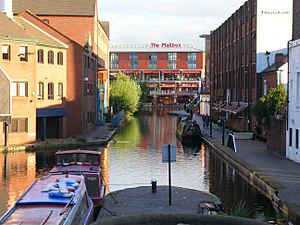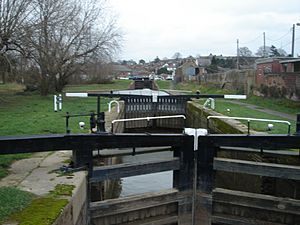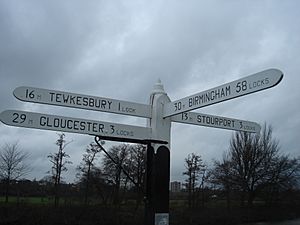Worcester and Birmingham Canal facts for kids
The Worcester and Birmingham Canal is a waterway that connects the cities of Birmingham and Worcester in England. It begins in Worcester, branching off the River Severn, and finishes at Gas Street Basin in Birmingham. This canal is about 29 miles (47 km) long.
Along its path, the canal has 58 locks. These include the famous 30 Tardebigge Locks, which form one of the longest groups of locks in Europe. The canal rises 428 feet (130 m) as it travels from Worcester up to Birmingham.
Contents
Building the Canal: A Look Back
Building the Worcester and Birmingham Canal was a big project. A special law was passed in 1791 to allow it to be built. This law let the company raise a lot of money, about £180,000 (which would be millions today). They sold shares, like small pieces of ownership, to get the money. If they needed more, they could raise extra funds. The law also allowed landowners to build wharves (places to load and unload boats). If landowners didn't, the company could build them.
More laws were passed later to help raise even more money. The canal needed a lot of funding to be completed.
Who Designed and Built It?
Several people helped plan and build the canal. Josiah Clowes and John Snape surveyed the land to figure out the best route. The engineers in charge changed over time. Some of them included Thomas Cartwright, John Woodhouse, and William Crosley.
Construction Progress
Work on the canal started in 1792 from the Birmingham end. It was designed to be wide enough for two barges, about 14 feet (4.3 m) across. However, building was slow.
By 1795, the canal reached Selly Oak. In 1796, it got to Kings Norton Junction, where it met another canal, the Stratford-upon-Avon Canal. A long tunnel, the 2726-yard (2493 m) Wast Hills Tunnel, opened in 1797. This allowed boats to travel to Hopwood.
By 1807, the canal reached Tardebigge. From Birmingham to the top of the Tardebigge locks, the canal is at a high level, called the 453 ft Birmingham Level.
Lock Sizes
Building wide locks for the whole canal was too expensive. So, the 56 locks that go down towards Worcester were built for narrower boats, about 7 feet (2.1 m) wide. The last two locks, which connect to the River Severn in Worcester, were built wider (14 feet or 4.3 m). This allowed larger river boats to enter Diglis Basin.
The final part of the canal, about 16 miles (26 km) long, opened in December 1815.
Connecting Canals and Users
The Dudley Canal Line No 2 was built to meet the Worcester and Birmingham Canal at Selly Oak in 1798. It went through the Lapal Tunnel. However, this tunnel kept collapsing and was eventually closed in 1917. Today, a group called The Lapal Canal Trust is working to bring part of it back to life, with a new route around the old tunnel.
A very important company that used the canal was Cadbury. Their chocolate factories in Bournville and Blackpole, Worcester, relied on the canal for transport.
Birmingham End of the Canal
For many years, boats on the Worcester and Birmingham Canal could not directly connect to the Birmingham Canal Navigations (BCN). A physical barrier, called the Worcester Bar, was built at Gas Street Basin in Birmingham. This was to stop water from the BCN, which was at a higher level, from flowing into the Worcester and Birmingham Canal.
This meant that goods had to be moved by hand from boats on one side of the bar to boats on the other. It was a lot of hard work! In 1815, a new law allowed a special lock to be built, and the bar was opened up. The Worcester and Birmingham Canal even raised its water level slightly to help reduce water loss. Today, the lock gates are gone, but the bar still exists, with boats often tied up on both sides.
The main commercial area in Birmingham for the canal was Worcester Wharf. This was a large complex of buildings and docks. Part of this area is now a modern shopping and living complex called The Mailbox.
Canal and Railways
Birmingham West Suburban Railway
After the new Birmingham New Street railway station was built, some business people saw a need for more railway lines to the south. They suggested building a new railway line that would follow the route of the Worcester and Birmingham Canal. This line would connect to another railway, the Birmingham and Gloucester Railway, and allow trains to reach the new station at Kings Norton.
The Midland Railway company helped pay for this new railway. They made a deal with the canal company, which was losing money at the time. The railway company would pay the canal company rent for using their land. Building started in 1873, and the railway was open by 1875.
The railway originally ended at Granville Street railway station and later at a large goods station. Both of these stations are now gone.
Today, this railway line is a big part of the Cross-City Line. This modern train line even runs in a tunnel under the canal, near the Holliday Street Aqueduct.
The Canal Today
At Selly Oak, a new bridge for the canal was built in 2011. It's called the 'Ariel Aqueduct' and carries the canal over a new section of the A38 road.
The canal is now very popular for fun activities. Many people enjoy leisure boating on narrowboats. There are places to rent narrowboats at Alvechurch, Worcester, Tardebigge, Dunhampstead, and Stoke Prior.
The canal is also part of popular boating routes called "cruising rings." One is the Stourport Ring, which is 74 miles (119 km) long and has 105 locks. It uses parts of four different waterways. Another is the Avon Ring, which is 109 miles (175 km) long with 129 locks, also using four waterways.
|





